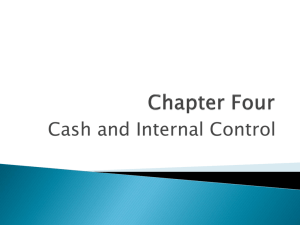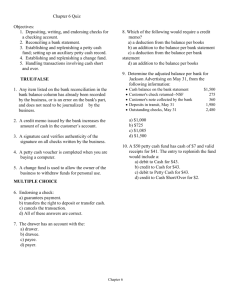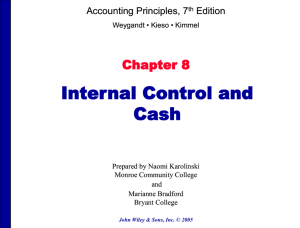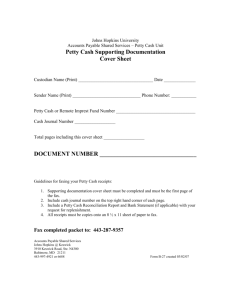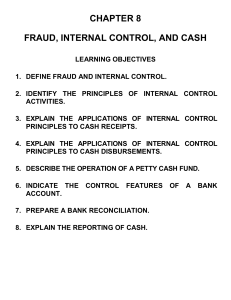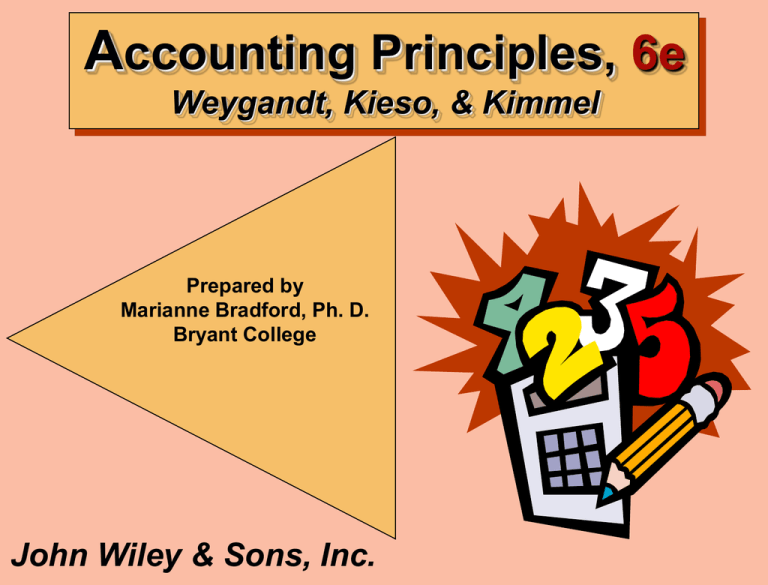
Accounting Principles, 6e
Weygandt, Kieso, & Kimmel
Prepared by
Marianne Bradford, Ph. D.
Bryant College
John Wiley & Sons, Inc.
CHAPTER 8
INTERNAL CONTROL AND CASH
After studying this chapter, you should be able to:
1 Define internal control.
2 Identify the principles of internal control.
3 Explain the applications of internal control principles to
cash receipts.
4 Explain the applications of internal control principles to
cash disbursements.
5 Describe the operation of a petty cash fund.
6 Indicate the control features of a bank account.
7 Prepare a bank reconciliation.
8 Explain the reporting of cash.
PREVIEW OF CHAPTER 8
Internal Control and Cash
Internal Control
Cash Controls
Principles
Control
Limitations
Control
over cash receipts
over cash
disbursements
PREVIEW OF CHAPTER 8
Internal Control and Cash
Use of a Bank
Making
deposits
Writing
checks
Bank
statements
Reconciling
the bank account
Reporting Cash
STUDY OBJECTIVE 1
Define internal control.
INTERNAL CONTROL
Internal control consists of the plan of
organization and all the related methods
and measures adopted within a business
in order to:
1 Safeguard its assets
2 enhance the accuracy
and reliability of its
accounting records
STUDY OBJECTIVE 2
Identify the principles of internal control.
ILLUSTRATION 8-1
PRINCIPLES OF INTERNAL CONTROL
Establishment of
responsibility
Segregation of duties
Documentation procedures
Physical, mechanical,
and electronic controls
Independent internal
verification
Other controls
PRINCIPLES OF
INTERNAL CONTROL
Establishment of responsibility: control is
most effective when only one person is
responsible for a given task.
Segregation of duties: the work of one
employee should provide a reliable
basis for evaluating the work of
another employee.
Documentation procedures: documents
provide evidence that transactions and events
have occurred.
PRINCIPLES OF
INTERNAL CONTROL
Physical, mechanical, and electronic controls:
relate primarily to the safeguarding of assets
and enhancing accuracy and reliability of the
accounting records
Independent internal verification: the
review, comparison, and reconciliation
of information from two sources.
Other controls: bonding of employees who
handle cash, rotating employee’s duties, and
requiring employees to take vacations.
ILLUSTRATION 8-2
PHYSICAL, MECHANICAL, AND
ELECTRONIC CONTROLS
Locked warehouses and storage cabinets
for inventories and records
Safes, vaults, and safety deposit boxes for
cash and business papers
Time clocks for recording time worked
ILLUSTRATION 8-2
PHYSICAL, MECHANICAL, AND
ELECTRONIC CONTROLS
Computer facilities with pass key access
Alarms to prevent break-ins
Television monitors and garment sensors
to deter theft
INDEPENDENT INTERNAL
VERIFICATION
To obtain maximum benefit from independent
internal verification:
1 The verification should be made
periodically or on a surprise basis.
2 The verification should be done by someone
who is independent of the employee
responsible for the information.
3 Discrepancies and exceptions should be
reported to a management level that can
take appropriate corrective action.
INDEPENDENT INTERNAL
VERIFICATION
Independent internal verification is often
assigned to internal auditors.
Internal auditors evaluate the effectiveness
of the company’s system of internal
control on a continuous basis.
Internal auditing is a professional activity
within a company, often
with direct access to
the board of directors.
ILLUSTRATION 8-3
COMPARISON OF SEGREGATION OF DUTIES PRINCIPLE
WITH INDEPENDENT INTERNAL VERIFICATION PRINCIPLE
Segregation
of Duties
Assistant Cashier B
Accounting Employee A
Maintains cash balances
per books
Maintains custody of
cash on hand
Independent Internal Verification
Assistant Treasurer A
Makes monthly comparisons: reports any unreconcilable differences to treasurer
LIMITATIONS OF
INTERNAL CONTROL
Costs of establishing control procedures
should not exceed their expected benefits
according to the concept of reasonable
assurance.
The human element is an important factor in every
system of internal control. A good system can
become ineffective through employee fatigue,
carelessness, or indifference.
Collusion may result when two or more
individuals work together to get around
prescribed controls and may significantly
impair the effectiveness of a system.
CASH
Cash consists of coins, currency,
checks, money orders, and money on
hand or on deposit at a bank or
similar depository.
Internal control over cash is
imperative in order to
safeguard cash and assure
the accuracy of the
accounting records for cash.
STUDY OBJECTIVE 3
Explain the applications of internal
control principles to cash receipts.
CONTROL OVER
CASH RECEIPTS
Only designated personnel should be
authorized to handle or have access to cash
receipts.
Different individuals should:
1 receive cash
2 record cash receipt transactions
3 have custody of cash
CONTROL OVER
CASH RECEIPTS
Documents should include:
1 remittance advices
2 cash register tapes
3 deposit slips
Cash should be stored in safes and bank vaults
Access to storage areas should be limited to
authorized personnel
Cash registers should be used in executing
over-the-counter receipts
CONTROL OVER
CASH RECEIPTS
Daily cash counts and daily comparisons
of total receipts.
All personnel who handle cash
receipts should be bonded and
required to take vacations.
Control of over-the-counter
receipts is centered on cash
registers that are visible to customers.
STUDY OBJECTIVE 4
Explain the applications of internal
control principles to cash disbursements.
CONTROL OVER CASH
DISBURSEMENTS
Payments are made by check rather
than by cash, except for petty cash
transactions.
Only specified individuals should
be authorized to sign checks.
Different departments or individuals
should be assigned the duties of approving
an item for payment and paying it.
CONTROL OVER CASH
DISBURSEMENTS
Prenumbered checks should be used and
each check should be supported by an
approved invoice or other
document.
Blank checks should be stored
in a safe.
1 Access should be restricted to
authorized personnel.
2 A check writer machine should be used
to imprint the amount on the check in
indelible ink.
CONTROL OVER CASH
DISBURSEMENTS
Each check should be compared with
the approved invoice before it is issued.
Following payment, the approved
invoice should be stamped PAID.
VOUCHER SYSTEM
The voucher system is often used to enhance
the internal control over cash disbursements.
It is an extensive network of approvals by
authorized individuals acting independently
to ensure that all disbursements by check are
proper.
A voucher is an authorization form prepared
for each expenditure.
Vouchers are recorded in a journal called the
voucher register.
ELECTRONIC FUNDS
TRANSFER SYSTEM
Processing checks is expensive; therefore new
methods are being developed to transfer funds
among parties without the use of paper.
Electronic Funds Transfer (EFT) System
is a disbursement system that uses
wire, telephone, telegraph, or
computer to transfer cash from one
location to another.
Regular payments such as those for
house, car, and utilities are frequently
made by EFT.
STUDY OBJECTIVE 5
Describe the operation of a petty cash
fund.
PETTY CASH FUND
A petty cash fund is used to pay relatively small
amounts
Operation of the fund, often called an imprest
system, involves:
1 establishing the fund
2 making payments from the fund
3 replenishing the fund
Accounting entries are required when:
1 the fund is established
2 the fund is replenished
3 the amount of the fund is changed
ESTABLISHING THE FUND
Two essential steps in establishing a petty
cash fund are
1 appointing a petty cash custodian who
will be responsible for the fund and
2 determining the size of the fund.
Ordinarily, the amount is expected to
cover anticipated disbursements for a 3 to
4-week period.
ESTABLISHING THE FUND
GENERAL JOURNAL
Date
Mar. 1
Account Titles and Explanation
Petty Cash
Cash
(To establish a petty cash fund)
Debit
Credit
100
100
When the fund is established, a check payable to the
petty cash custodian is issued for the stipulated amount.
REPLENISHING THE FUND
When the money in the petty cash fund
reaches a minimum level, the fund is
replenished.
The request for reimbursement is initiated
by the petty cash custodian.
The petty cash custodian prepares a
schedule of the payments that have been
made and sends the schedule, with
supporting documentation, to the
treasurer’s office.
REPLENISHING THE FUND
GENERAL JOURNAL
Date
Mar. 15
Account Titles and Explanation
Postage Expense
Freight-out
Miscellaneous Expense
Cash
(To replenish petty cash fund)
Debit
44
38
5
Credit
87
On March 15 the petty cash custodian requests a check for
$87. The fund contains $13 cash and petty cash receipts for
postage $44, freight-out $38, and miscellaneous expenses,
$5.
REPLENISHING THE FUND
GENERAL JOURNAL
Date
Mar. 15
Account Titles and Explanation
Postage Expense
Freight-out
Miscellaneous Expense
Cash Over and Short
Cash
(To replenish petty cash fund)
Debit
44
38
5
1
Credit
88
On March 15 the petty cash custodian requests a check for
$88. The fund contains $12 cash and petty cash receipts for
postage $44, freight-out $38, and miscellaneous expenses,
$5.
STUDY OBJECTIVE 6
Indicate the control features of a bank account.
USE OF A BANK
The use of a bank minimizes the amount of
currency that must be kept on hand and
contributes significantly to good internal
control over cash.
A company can safeguard
its cash by using a bank as
a depository and as a
clearing house for checks
received and checks written.
WRITING CHECKS
A check is a written order signed by the
depositor directing the bank to pay a specified
sum of money to a designated recipient.
Three parties to a check are:
1 Maker (drawer) issues the check
2 Bank (payer) on which check is drawn
3 Payee to whom check is payable
BANK STATEMENTS
A bank statement shows:
1 checks paid and other debits charged against the
account
2 deposits and other credits made to the account
3 account balance after each day’s transactions
MEMORANDA
Bank debit memoranda indicate
charges against the depositor’s
account.
Example: ATM service charges
Bank credit memoranda indicate
amounts that will increase the
depositor’s account.
Example: interest income on
account balance
STUDY OBJECTIVE 7
Prepare a bank reconciliation.
RECONCILING THE
BANK ACCOUNT
Reconciliation is necessary because
the balance per bank and balance per
books are seldom in agreement due to
time lags and errors.
A bank reconciliation should be
prepared by an employee
who has no other
responsibilities
pertaining to cash.
RECONCILING THE
BANK ACCOUNT
Steps in preparing a bank reconciliation:
1 Determine deposits in transit
2 Determine outstanding checks
3 Note any errors discovered
4 Trace bank memoranda to the records
Each reconciling item used in determining
the adjusted cash balance per books should
be recorded by the depositor
ILLUSTRATION 8-14
BANK RECONCILIATION
LAIRD COMPANY
Bank Reconciliation
April 30, 2002
Cash balance per bank statement
Add: Deposits in transit
Less: Outstanding checks
No. 453
No. 457
No. 460
The bank statement for
the Laird Company
shows a balance per
bank of $15,907.45 on
April 30, 2002.
$ 15,907.45
2,201.40
18,108.85
$ 3,000.00
1,401.30
1,502.70
Adjusted cash balance per bank
$ 12,204.85
Cash balance per books
Add: Collection of $1,000 note receivable plus interest earned
$50, less collection fee $15
Error in recording check 443
Less: NSF check
Bank service charge
Adjusted cash balance per books
5,904.00
On this date the
balance of cash per
books is $11,589.45.
$ 11,589.45
$ 1,035.00
36.00
425.60
30.00
1,071.00
12,660.45
455.60
$ 12,204.85
ENTRIES FROM BANK
RECONCILIATION
GENERAL JOURNAL
Date
Apr. 30
Account Titles and Explanation
Cash
Miscellaneous Expense
Notes Receivable
Interest Revenue
(To record collection of notes
receivable by bank)
Debit
Credit
1035
15
1000
50
Collection of Note Receivable This entry involves four
accounts. Interest of $50 has not been accrued and the
collection fee is charged to Miscellaneous Expense.
ENTRIES FROM BANK
RECONCILIATION
GENERAL JOURNAL
Date
Apr. 30
Account Titles and Explanation
Cash
Accounts Payable — Andrea
Company
(To correct error in recording
check No. 443)
Debit
Credit
36
36
Book Error An examination of the cash disbursements
journal shows that check No. 443 was a payment on
account to Andrea Company, a supplier. The check, with
a correct amount of $1,226.00, was recorded at $1,262.00.
ENTRIES FROM BANK
RECONCILIATION
GENERAL JOURNAL
Date
Apr. 30
Account Titles and Explanation
Accounts Receivable — J. R. Baron
Cash
(To record NSF check)
Debit
Credit
425.6
NSF Check An NSF check becomes an
accounts receivable to the depositor.
425.6
ENTRIES FROM BANK
RECONCILIATION
GENERAL JOURNAL
Date
Apr. 30
Account Titles and Explanation
Miscellaneous Expense
Cash
(To record charge for printing
company checks)
Debit
Credit
30
30
Bank Service Charges Check printing charges (DM) and
other bank service charges (SC) are debited to Miscellaneous
Expense because they are usually nominal in amount.
STUDY OBJECTIVE 8
Explain the reporting of cash.
REPORTING CASH
Cash reported on the Balance Sheet
includes:
1 Cash on Hand
2 Cash in banks
3 Petty Cash
Cash is listed first in the balance sheet
under the title cash and cash
equivalents because it is the most liquid
asset.
CASH EQUIVALENTS
Cash equivalents are highly liquid
investments that can be converted
into a specific amount of cash.
They typically have maturities of
3 months or less when purchased
Examples include money market
funds, bank certificates of deposit,
and U.S. Treasury bills and notes.
COPYRIGHT
Copyright © 2002 John Wiley & Sons, Inc. All rights reserved. Reproduction or
translation of this work beyond that permitted in Section 117 of the 1976 United
States Copyright Act without the express written consent of the copyright owner is
unlawful. Request for further information should be addressed to the Permissions
Department, John Wiley & Sons, Inc. The purchaser may make back-up copies for
his/her own use only and not for distribution or resale. The Publisher assumes no
responsibility for errors, omissions, or damages, caused by the use of these
programs or from the use of the information contained herein.
CHAPTER 8
INTERNAL CONTROL AND CASH

